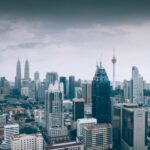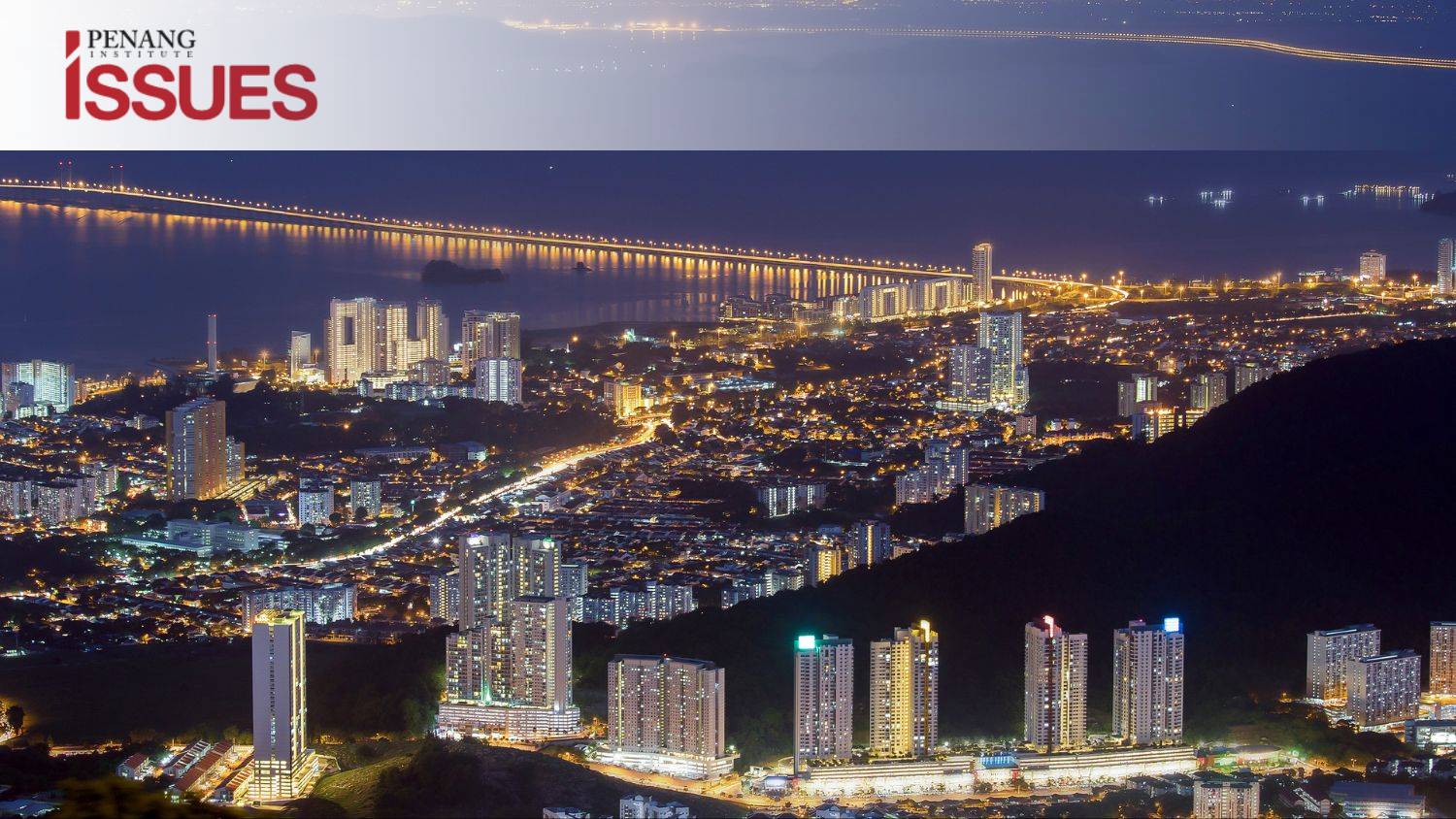
Guest Writers: Dr. Erdinç Çakmak (Associate Professor, Breda University of Applied Sciences, The Netherlands), Dr. Rami Isaac (Associate Professor, Breda University of Applied Sciences, TheNetherlands) and Dr. Vikneswaran Nair (Professor, DISTED College, Penang)
Executive Summary
- Conducted in Penang, Malaysia, in March 2024 by Breda University master’s students and local stakeholders, this study focused on four tourist zones: George Town, Penang Hill and Penang National Park, the Tourism Belt (Tanjung Tokong to Batu Ferringhi), and Gurney Drive, evaluating the balance between economic growth, tourism development, sustainability, and community welfare.
- The study was conducted using a unique and robust triangulated research methodology. This included semi-structured interviews, area mapping, netnography, thematic analysis, and data from reputable sources such as Tripadvisor, Google Reviews, questionnaires, and Photo Voice. This approach ensured a diverse range of insights from a wide range of stakeholders, making the findings more comprehensive and reliable.
- The study’s key findings reveal that George Town and Gurney Drive are experiencing tensions between rapid tourism growth and urban liveability. Penang Hill and Penang National Park are successfully balancing visitor numbers with conservation. The TourismBelt is struggling with revitalising tourism and addressing environmental degradation. Future projections paint a picture of exciting possibilities. George Town is poised to grow as a cultural tourism hub, requiring innovative traffic and public transport solutions. Penang Hill and Penang National Park could see infrastructural developments that supporteco-tourism. The Tourism Belt, with the right measures, could revitalise its tourism and high-end tourism and medical hub, with careful urban planning.
- The strategic recommendations are not just suggestions, but urgent priorities. They call for sustainable infrastructure to support tourism growth without harming local life or the ecology, diversification in tourism offerings (cultural, eco-friendly, and medical tourism),increased community involvement in planning to meet local needs and preserve cultural heritage, and stringent conservation measures in natural parks and coastal areas.
Study Background
This study, conducted over four weeks in March 2024 by Breda University researchers and Penang stakeholders, evaluated the future of four key tourist zones on Penang Island: (1) George Town, (2) Penang Hill and Penang National Park, (3) the Tourism Belt (Tanjung Tokong to Batu Ferringhi), and (4) Gurney Drive. It explored the balance between economic growth, tourism development, sustainability, and community welfare. Using a triangulated research methodology that included semi-structured interviews, area mapping, netnography, and thematic analysis, the study engaged various stakeholders to gather diverse insights.
The findings highlight the tension between tourism growth and urban liveability, economic impacts, and the need for cultural and environmental sustainability. Future projections and strategic recommendations focus on sustainable infrastructure, economic diversification, community engagement, and environmental conservation to ensure Penang’s long-term welfare and attractiveness as a global tourism destination.
KEY TOURIST ZONE 1
George Town: An Analysis of Tourism Development and Liveability
The analysis of Key Tourist Zone 1 was aimed at forecasting George Town’s probable future. It focused on the interaction between tourism growth and liveability and its implications for local micro and small enterprises (MSEs).
Stakeholder interviews include Angel Tours, Asia Camera Museum, Asia Travel Adventure, Campbell Hotel, Chew Jetty, Cruise Ship The Ambiance, DISTED College Penang, Eastern &Oriental Hotel, Fort Cornwallis Management, Friendly Mart, GRAB driver, Gravybaby Restaurant,H.S. Sam’s Book Store, Local guide, Penang City Council, Penang Tourist Guide Association, Peranakan Heritage Mansion, Roman Catholic Penang Diocesan Museum, Royale Chulan Hotel, Taxi driver, Think City, Tourism Malaysia Office and Wonder Food Museum.
In terms of tourism development, George Town has developed significantly since it was nominated as a UNESCO World Heritage Site in 2008, with increasing tourist arrivals shown from 2009 until 2023 (see Figure 1). While the UNESCO designation increased tourist visits and encouraged the development of new hospitality and tourism businesses, George Town was well-known for its diversified cultural history, historic sites, and street art scene already before obtaining the UNESCO title. Nowadays, tourists are still drawn to places like the Penang Museum and other exhibitions, the Cemetery, Fort Cornwallis, and the Town Hall. Furthermore, the city’s rich history, gastronomic options, and charming small-town ambience create an attractive destination appeal (The Economic Times, 2018).
Figure 1: Annual International Tourist Arrivals from 2009 to 2023
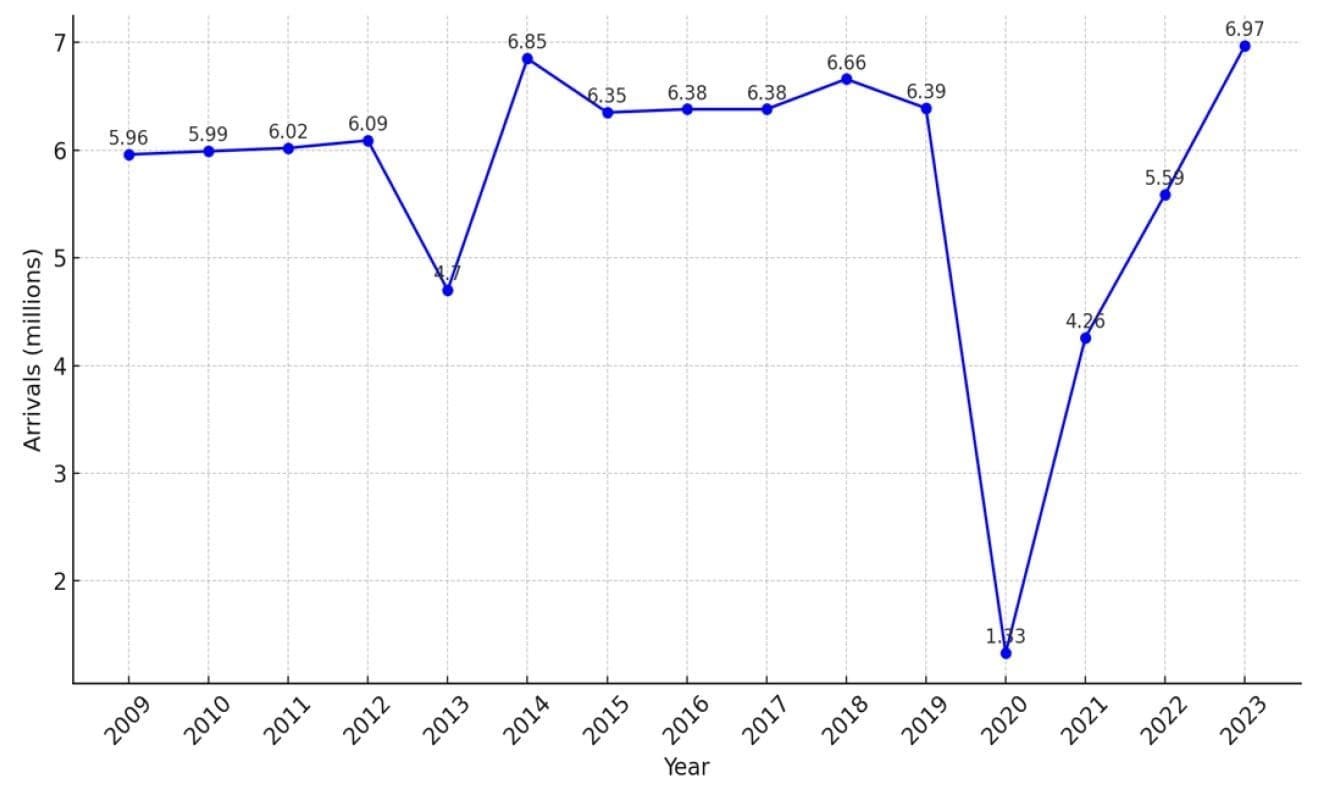
Over time, George Town has strategically embraced historical tourism as an approach to promoting economic growth. Developments include efforts to renovate historical buildings and areas to attract more tourists. Apparently, as several of the respondents mentioned, there has been a conscious effort to balance the benefits of tourism with the preservation of local heritage and its cultural identity.
Key Findings
The study highlights the tension between tourism growth and city liveability, noting infrastructure issues, economic benefits, and demographic concerns. It also emphasises the challenge of balancing development with preserving George Town’s cultural heritage. (See Figure 2 for further details).
Figure 2: Key Finding from Tourist Zone 1

The Future of George Town
George Town is projected to see a substantial increase in tourism, driven by easier visa processes, technological advancements in tourism management, and more direct flights. However, this growth is expected to strain local infrastructure, necessitating improvements in traffic management and public transportation, including new tram lines. The city is at a crossroads, needing to manage its growth sustainably while enhancing its status as a tourist hub and maintaining its liveability for residents. In short, the future of George Town, Penang, as a tourism destination, appears to be focused on balancing growth with sustainability and heritage preservation. Key points drawn from the study include:
1. Sustainable Tourism Development: George Town will likely continue developing its tourism sector with a strong emphasis on sustainable practices. This involves managing tourism’s environmental impact, as highlighted by Belsoy et al. (2012) in their study on environmental impacts in protected areas. The city must tackle challenges related to preserving its cultural heritage while accommodating tourists, as Cahill (2024) has noted regarding heritage tourism as a double-edged sword.
2. Promotion and Attraction Strategies: Recent efforts to attract more tourists include promotions targeting visa-free travellers (Bernama, 2023). This suggests an active strategy to increase international tourist arrivals by leveraging Penang’s appeal as an accessible destination.
3. Heritage and Cultural Focus: The preservation of heritage buildings and the cultural fabric of George Town continues to be a priority, as evident from the incentives for repairing heritage buildings (George Town World Heritage Incorporated, 2024). This focus not only enhances the cultural tourism experience but also helps maintain the city’s UNESCO World Heritage status.
4. Infrastructure Development: Improvements in transportation and infrastructure, such as those reported by Penang Infrastructure Corporation (2023) and updates in cruise terminal facilities (Penang Port Commission, 2024ab), are likely to make George Town more accessible and attractive to tourists. This aligns with the broader aim of improving visitor experiences and managing increased tourist flows.
5. Economic Impact: The resurgence in cruise tourism and the overall increase in passenger arrivals (Dermawan, 2024abc) indicate a robust recovery and potential growth in the tourism sector, which will contribute significantly to the local economy. This growth is critical in the post-pandemic economic recovery phase.
6. Challenges and Concerns: However, the city faces challenges related to mass tourism, such as those discussed by Chong (2019), and Kizielewicz and Luković (2015), which include the negative impacts on local communities and the environment. Addressing these challenges requires integrated planning and community involvement.
7. Strategic Planning and Community Engagement: The formulation and implementation of the Penang Tourism Master Plan 2021-2030 (Penang State Exco for Tourism, Arts, Culture, and Heritage, 2021) highlight a strategic approach to tourism development that likely includes stakeholder engagement and sustainable practices.
George Town’s future as a tourism destination will likely see continued growth. To balance tourism’s benefits and drawbacks, there will be a strong emphasis on sustainability, heritage preservation, and strategic promotion. This approach will be crucial in maintaining George Town’s status as a vibrant, attractive, and responsible tourist destination.
Implications
The studies suggest significant implications for local stakeholders. MSEs must adapt to the changing dynamics, focusing on sustainability and capitalising on increased tourism. Policymakers are called upon to balance tourism growth with heritage preservation and infrastructure development. Stakeholder cooperation must ensure that development benefits visitors and residents without compromising the city’s cultural heritage. In conclusion, George Town faces challenges and opportunities with its future growth as a tourism hub. It requires careful planning and collaborative effort to ensure sustainable development and maintain its unique character and liveability for future generations.
KEY TOURIST ZONE 2
Penang Hill and Penang National Park: Integrated Conservation and Tourism Development
The analysis of Key Tourist Zone 2, Penang Hill and Penang National Park, was determined by focusing on their roles within the Penang Biosphere Reserve. The objective was to understand the interplay between conservation efforts and economic activities, especially the impact on medium and large organisations (MLOs) and micro and small enterprises (MSEs) operating within it. Stakeholder interviews were carried out with representatives from Penang Hill Corporation, The Habitat Foundation, Penang National Park, Penang Hill Corporation, USM-Marine Conservation National Park and Monkey Beach Resort.
In the Penang Tourism Masterplan (2021-2030), all development on this hill is focused on ecotourism, which includes creating a Rainforest Research Centre, developing a new transport to the top of Penang Hill in the form of a Cable Car, and renovating the Colonial Bungalows. The tasks within the project are prioritised as “Major Project” (MP), “Low Priority” (LP) and “Effort Less” (EL)(see Figure 3).
Figure 3: Priority Project at Penang Hill as indicated in Penang Tourism Masterplan (2021-2030)

Key Findings
Penang Hill faces challenges with rising visitor numbers and infrastructure, with a new cable car system planned to improve accessibility. On the other hand, Penang National Park prioritises conservation over visitor growth, focusing on maintaining trails and infrastructure with sustainable expansion (see Figure 5).
Figure 4: Key Findings from Tourist Zone 2

Future Projections
Penang Hill: The anticipated completion of the cable car project is expected to diversify visitor demographics and boost total visitor numbers, potentially enhancing economic benefits but posing challenges in managing increased foot traffic and maintaining ecological balance. The environmental impact created by this project needs further resolution with all the stakeholders.
Penang National Park: Plans to bolster its conservation role include improving trail conditions and promoting eco-friendly tourism practices. The park aims to balance generating visitor fees with maintaining accessibility and quality visitor experiences.
Hence, the future of Penang Hill and Penang National Park as tourism destinations is closely tied to sustainable tourism and destination management strategies. The following should be the focus on these key areas:
1. Sustainable and Eco-Friendly Initiatives:
Penang Hill and Penang National Park are increasingly positioning themselves as eco-tourism destinations. Initiatives like the Trash Free Hill event (Penang Hill Corporation, 2023) and the designation of Penang Hill as a UNESCO Biosphere Reserve (Dato’ Harry, 2021) indicate a commitment to sustainable tourism practices. The focus is on preserving natural and cultural heritage while accommodating tourists.
2. Managing Tourist Numbers and Impact:
The growth in tourist arrivals (Dermawan, 2024, January 29) poses challenges and opportunities for destination management. Effective management strategies are needed to balance tourist influx, especially in sensitive areas like biosphere reserves, to minimize ecological footprints. Concerns around the Penang Hill cable car (Nair, 2024, March 21) highlight the need for careful infrastructure development that considers environmental impacts.
3. Enhancing Tourist Experience:
The development of unique experiences such as starlight camping and virtual reality wildlife experiences (The Habitat Penang Hill, 2024ab) points towards creating memorable and immersive experiences that also educate tourists about the environment. Such offerings can enhance the appeal of Penang as a destination while promoting conservation awareness.
4. Infrastructure and Accessibility:
Discussions around the Penang Hill cable car controversy indicate ongoing debates about improving accessibility versus preserving the destination’s natural and cultural essence (Nair, 2024). Balancing these aspects is crucial for sustainable destination development.
5. Economic Considerations:
The tourism master plan and various stakeholders like local boat operators and businesses are focused on economic benefits while urging minimal charges and sustainable practices (Penang State EXCO Office for Tourism and Creative Economy, 2021; New Straits Times, 2021). This indicates an awareness of the need to make tourism economically beneficial for local communities while maintaining a low environmental impact.
6. Education and Community Engagement:
Initiatives like environmental education (Tan, 2024) and community engagement programmes aim to involve local populations and tourists in conservation efforts, increasing the value placed on preserving natural resources.
7. Global and Regional Tourism Trends:
The rise of nature tourism (Alexander, 2023) and the concept of ‘revenge travel’ post-pandemic (Kamath, 2024) suggest that Penang’s natural attractions might see increased interest. This requires robust management to handle increased visitation without degrading the natural assets.
The future of Penang Hill and Penang National Park as tourism destinations is likely to be shaped by their ability to implement sustainable tourism practices that balance ecological conservation with tourist satisfaction and economic benefits. This will involve careful planning and coordination among various stakeholders, including government agencies, tourism operators, local communities, and conservation groups.
Implications
The future trajectories of Penang Hill and Penang National Park underscore a critical dynamic between development and conservation. While Penang Hill is poised to accommodate more visitors and stimulate local economic growth, it faces challenges with crowd management and infrastructure development. Conversely, Penang National Park continues to strengthen its conservation efforts, possibly at the expense of reduced visitor numbers and local business viability due to implementing a conservation fee.
The studies highlight the need for sustainable management practices that consider both ecological conservation and the requirements of an evolving tourism market. For MLOs and MSEs operating within these areas, adapting to these changes is imperative to support the overarching goals of the Penang Biosphere Reserve. This involves fostering partnerships, enhancing visitor experiences, and contributing to conservation efforts—all vital for the sustainable future of these important ecological and tourist sites. In conclusion, managing the dual approach of boosting tourism at Penang Hill and enhancing conservation at Penang National Park requires careful planning and stakeholder cooperation to ensure that both areas continue offering unique attractions without compromising their foundational values.
KEY TOURIST ZONE 3
Penang’s Tourism Belt from Tanjung Tokong to Batu Ferringhi: A Comprehensive Analysis of Trends and Implications
An in-depth analysis of Key Tourist Zone 3 on the future of Penang’s Tourism Belt, comprising areas in Tanjung Tokong, Tanjung Bungah, and Batu Ferringhi was conducted to understand the evolving dynamics between tourism development and community sustainability, focusing on medium and large organisations (MLOs) and micro and small enterprises (MSEs).
Stakeholder interviews were conducted with representatives from 24xpress, Art gallery, Coffee Bean and Tea Leaf, DISTED College, Eco Coach & Tours, Grab Drivers, Green City George Town developments, Guardian City Junction Plaza, Hard Rock Cafe Store, Home Café, InDrive, Island 88 store, Island Plaza – Thrift shop, Juice 360 shop outlet, Korean Soap Store, Korean Supermarket, Local bag store, Paradise Beach resort, Precinct 10 Resto outlet, Somore beauty treatment store, Starbucks, Tanjung Bungah Night Market, Taxi, The coffee bean: Straits Quay, Tomorrow Café, Tupperware store, Uniqlo, Vet store, World Travellers by Tripartite and Zus. The Tourism Belt faces significant challenges impacting its development and appeal. Key issues include a lack of amenities beyond water activities and beaches, leading to a diminished tourist experience. Limited road access results in traffic congestion and environmental degradation, exacerbated by climate change and poor water management, which has deteriorated beach conditions. Pollution, including sewage and oil spills, further contaminates the water. Hence, significant transformation is needed.
Key Outcomes
The research shows that redevelopment and market shifts in the Tourism Belt are affecting demographics and business. Tanjung Tokong and Tanjung Bungah are moving towards becoming residential and expat focused areas, while Batu Ferringhi remains a major tourist hub with ongoing investments. See Figure 5.
Figure 5: Key Finding from Tourist Zone 3

Future Projections
The future of the Tourism Belt in Penang, covering Tanjung Tokong, Tanjung Bungah, and Batu Ferringhi, is geared towards significant advancements and innovations in tourism management.
Tanjung Tokong and Tanjung Bungah are likely to see a decline in their roles as primary tourist destinations, and a shift towards more residential and service-oriented developments for permanent residents and expatriates.
Batu Ferringhi is expected to bolster its position as the primary tourism hub, driven by new developments that cater to its unique beach appeal and the anticipated increase in tourist arrivals seeking beach and leisure experiences.
Figure 6: The Tourism Belt encompassing Batu Ferringhi, Tanjung Bungah and Tanjung Tokong

This progression is driven by various strategic developments:
1. Infrastructure and Transportation:
The recent approval of the RM1 billion Penang International Airport expansion project is a key development that will greatly enhance accessibility and attract more tourists (Bagde et al., 2021; Bahari, 2024). Alongside this, the Penang Transport Master Plan is aiming to stream line transportation, further boosting the area’s appeal as a tourist destination (Bagde et al., 2021). All this will assist in the movement of tourism to the Tourism Belt.
2. Environmental and Recreational Projects:
The Phase One opening of the Gurney Bay project exemplifies efforts to improve local infrastructure while maintaining environmental sustainability, promising a better quality of life and enhanced tourist experiences (Dermawan, 2024).
3. Market Trends and Demographics:
The area is shifting towards attracting high-earning residents and expatriates, driven by upscale developments in Tanjung Tokong. This demographic change is likely to influence the local tourism scene, possibly shifting the focus from traditional to more sophisticated, high-end tourism offerings (Lin-Arlow, 2022; Malay Mail, 2022).
4. Gentrification and Socioeconomic Dynamics:
Rapid urbanisation and gentrification are reshaping the local cultural and economic landscapes, which
could lead to the displacement of local communities but may also open up new opportunities for luxury and cultural tourism (Picardo, 2022; Lin-Arlow, 2022).
5. Tourism Diversification:
The record-breaking performance of Penang’s business events sector suggests a thriving potential for MICE tourism, which could diversify the tourism base and spur further economic activities in the region (Chakraborty, 2024).
6. Cultural and Experiential Tourism:
There is an increasing trend towards offering more authentic, local experiences. Efforts to capitalise on gastronomic and cultural tourism are aligned with global trends and can provide a unique selling proposition for the area (Nasir et al., 2022).
Overall, the Tourism Belt in Penang is poised for a transformative future, with a focus on enhancing accessibility, expanding tourism markets, and incorporating sustainable practices. Strategic management and innovative marketing will be crucial in leveraging these developments, ensuring that growth is both sustainable and beneficial to all stakeholders involved (Penang State EXCO, 2021ab).
Implications
The evolving dynamics within the Tourism Belt present critical challenges and opportunities for MLOs and MSEs. Businesses must adapt to changing demographic and economic landscapes, especially in transitioning areas like Tanjung Tokong and Tanjung Bungah. Batu Ferringhi offers growth potential in tourism-related services, necessitating investments in quality accommodations and leisure activities to attract an international clientele. However, the overarching theme of stagnation followed by potential decline raises concerns. Without significant tourism-related development, effective marketing, and addressing environmental degradation and coastal erosion, the area could see a reduced appeal. The study underscores the need for innovative and adaptive strategies among local businesses, and calls for policymakers to focus on sustainable practices and infrastructure improvements that enhance the Tourism Belt’s environmental and economic resilience. Penang’s Tourism Belt stands at a pivotal juncture. Strategic actions are required to navigate the potential economic and social transformations influenced by shifting tourism patterns. Stakeholders must collaborate to implement sustainable solutions that ensure the Tourism Belt remains an attractive and vibrant destination for future generations.
KEY TOURIST ZONE 4
Gurney Drive: An In-Depth Analysis of Urban Transformation and Economic Implications
An analysis was carried out to determine the future ability of Gurney Drive to attract tourists. It focused on the impact of ongoing transformations on Medium and Large Organisations (MLOs) and investigated the Micro and Small Enterprises (MSEs) implications.
Stakeholder interviews were conducted with representatives from Ann & Bees, Ascott Hotel, Crafted
Cuisine Vegetarian Restaurant, DISTED College, E&O, Andaman Developer, Evergreen Notel, Farmasi d’Light, Flow Studio, G-Hotel, GRAB driver, Gurney Bay, Gurney Plaza, HCM Hospitality Consulting, Kapas Online Souvenir Company, Marriott Hotel, Northam Beach Café, Real Estate Corporation, Vegi Café, Vintage Retro Shop Young, Viva Local Food Haven, Vouk Hotel Suites and Wawasan Open University.
Key Outcomes
Gurney Drive is divided into segments for local needs, medical tourism, and leisure tourism at Gurney Bay. Significant investments in luxury and medical facilities aim to drive economic growth but raise concerns about affordability for locals. Developments spark debates on environmental sustainability and social changes, impacting local culture. Stakeholder impacts vary, with MSEs near Gurney Bay benefiting from increased tourism, while others face displacement and market changes due to rapid urbanisation (see Figure 7 for details).
Figure 7. Key Findings from Tourist Zone 4
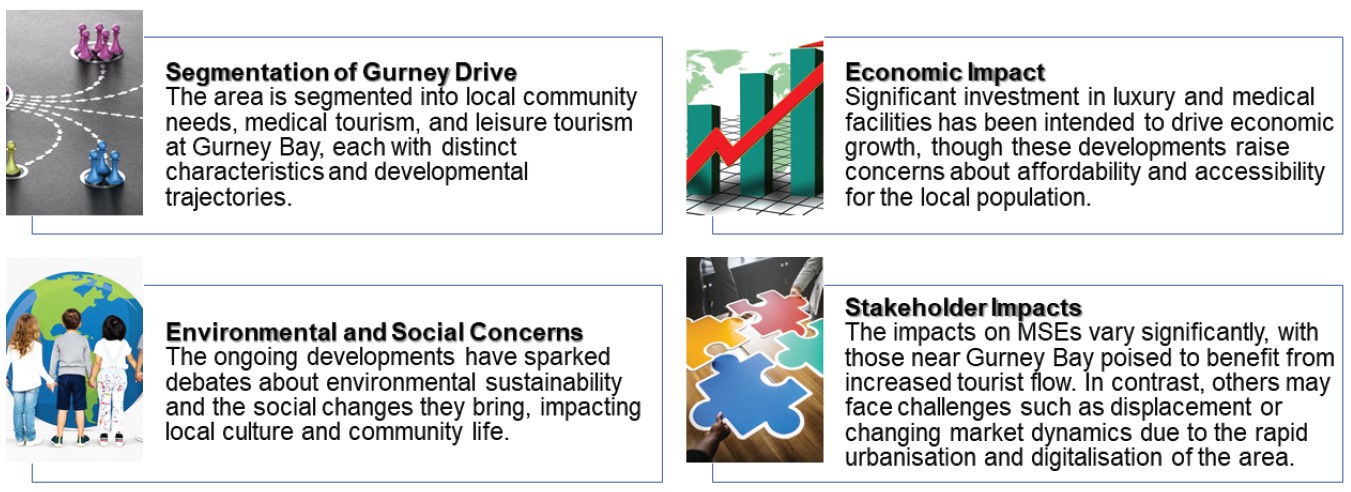
The Future of Gurney Drive
The future of Gurney Drive is characterised by a series of significant developments aimed at transforming it into a prime urban and tourist hub.
Luxury Tourism and Medical Tourism Expansion: The introduction of high-end accommodations and state-of-the-art medical facilities is expected to attract affluent medical tourists and enhance Gurney Drive’s reputation as a luxury destination and healthcare hub.
Gurney Bay Development: This ambitious project aims to transform Gurney Bay into a vibrant leisure and community space that will attract locals and tourists. However, waste management and traffic congestion are potential challenges.
Connectivity Improvements: As part of the Penang Transport Master Plan, new train lines are planned to alleviate traffic congestion and improve overall accessibility.
The future of Gurney Drive as a tourism destination seems promising and oriented towards sustainable and comprehensive urban development. Considering the references provided, several key trends and strategies emerge that could shape the future of Gurney Drive. They include:
1. Sustainable Development Initiatives:
Projects like Gurney Wharf indicate a shift towards sustainable urban development, which could enhance the appeal of Gurney Drive as a tourist destination. The project aims to combine urban comforts with the natural environment, thus promoting an eco-friendly approach to tourism (Buletin Mutiara, 2023; Tanjung Pinang Development).
2. Recovery and Adaptation Post-COVID-19:
The tourism industry in Malaysia, including Penang, was severely impacted by the COVID-19 pandemic. Efforts to revive the sector include calls for aid and support for tourism businesses (Business News Malaysia, 2021). Moreover, Malaysia’s broader tourism strategy to attract more visitors in 2024 and beyond indicates a strong governmental push to revitalise this sector, which will likely benefit Gurney Drive (Casey, 2024).
3. Digital and Virtual Tourism Initiatives:
The use of digital technologies and virtual reality experiences is becoming a part of Penang’s tourism strategy, which could help market Gurney Drive to a broader audience (The Sun, 2023).
4. Infrastructure Development:
Ongoing infrastructure developments, including public transport enhancements like LRT and BRT systems, are likely to make Gurney Drive more accessible and attractive to both domestic and international tourists (Penang Infrastructure Corporation, 2023).
5. Focus on Medical Tourism:
Gurney Drive’s proximity to medical facilities, coupled with Penang’s push towards becoming a hub for medical tourism, presents a unique selling point that could be leveraged to attract tourists seeking healthcare services (Wee, 2023; Hoay, 2020).
6. Cultural and Heritage Preservation:
Penang’s rich history and culture continue to be a significant draw for tourists. The preservation of heritage sites and the celebration of local culture and cuisine can enhance the visitor experience at Gurney Drive, maintaining its status as a culturally significant site (Khoo, 2014).
7. Environmental Challenges:
Issues like coastal erosion need addressing to ensure the long-term sustainability of tourism at Gurney Drive. Sustainable management practices will be crucial in maintaining the attractiveness and safety of the beach areas (McIntyre, 2022).
In summary, the future of Gurney Drive as a tourism destination in Penang looks geared towards an integrated approach combining sustainable development, infrastructural improvements, and innovative tourism strategies. This approach aims to not only help in the recovery from the setbacks of the COVID-19 pandemic but also to ensure the long-term sustainability and attractiveness of Gurney Drive as a premier destination in Malaysia.
Implications
The transformation of Gurney Drive presents complex challenges and opportunities. For businesses, particularly MSEs, adapting to the shifting economic landscape will be crucial. They may need to innovate and adjust their business models to cater to a more diverse and international clientele. For the local community, concerns about rising living costs and changes to the community structure necessitate active engagement and advocacy to ensure that developmental benefits are equitably shared.
The future of Gurney Drive hinges on the successful integration of economic development with sustainable practices. Stakeholders, including policymakers, business owners, and community leaders, must collaborate to ensure that the growth in Gurney Drive enhances rather than detracts from the area’s cultural and environmental heritage. Effective policy interventions and strategic planning will be essential to support MSEs through these transformative times and to preserve the cultural integrity of Gurney Drive.
SUMMARY OF FINDINGS
The Probable Future of Penang Tourism
To effectively manage and capitalise on the developments and challenges identified in the four key tourist zones of George Town, Penang Hill and Penang National Park, the Tourism Belt from Tanjung Tokong to Batu Ferringhi and Gurney Drive, stakeholders across these regions should consider the following action plan (see Figure 8):
Figure 8. Action Plan for the Future of Penang
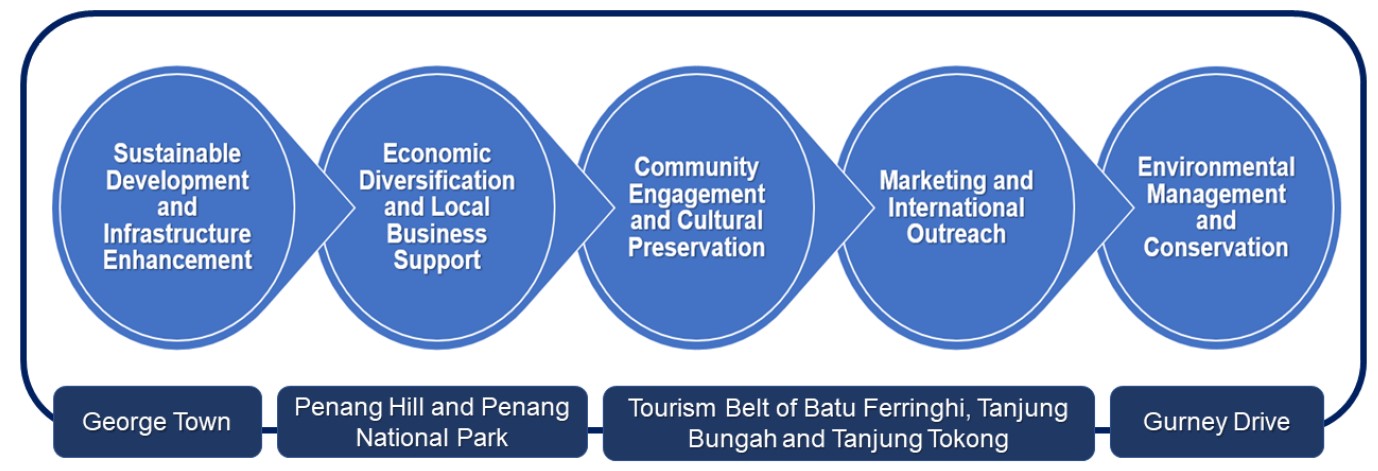
1. Sustainable Development and Infrastructure Enhancement
a. George Town: Implement sustainable tourism practices that balance the influx of tourists with the preservation of cultural heritage and infrastructure. Upgrade public transportation systems tO reduce traffic congestion and improve accessibility for tourists and locals. For example, the bus network can be expanded, and eco-friendly trams introduced within the city.
b. Penang Hill and Penang National Park: Develop infrastructure that supports eco-tourism and minimises ecological disruption while effectively managing the increasing tourist numbers. Construct boardwalks that prevent soil erosion and protect native plant species while allowing tourists to enjoy the natural environment. Use eco-friendly materials and involve local communities in maintenance.
c. Tourism Belt: Address environmental degradation and infrastructure needs to prevent the area’s tourism appeal from declining. Implement shoreline protection projects to combat coastal erosion, such as installing natural barriers like mangrove buffers, enhancing the area’s natural beauty and attracting eco-conscious tourists.
d. Gurney Drive: Enhance infrastructure to support the expected increase in tourism and medical services, focusing on traffic management and waste disposal systems to handle more significant visitor numbers. Develop a comprehensive waste management system that includes frequent recycling and collection services, especially in high-tourism areas, to handle increased waste from tourists and medical facilities effectively.
2. Economic Diversification and Local Business Support
a. George Town: Support MSEs through grants and training programmes to leverage tourism for economic benefit without compromising local culture. Launch a “Made in George Town” campaign to promote local artisans and cultural products, linking these with tourism packages that include workshops and local marketplace tours.
b. Penang Hill and Penang National Park: Encourage local entrepreneurship by promoting products and services that align with conservation efforts and eco-tourism. Create a certification programme for eco-friendly businesses operating in or near the parks to encourage sustainable practices and attract tourists willing to pay a premium for environmentally responsible services.
c. Tourism Belt: Innovate and diversify tourism products to revitalise the area and reduce economic stagnation. Develop a series of annual cultural festivals that celebrate local heritage and attract visitors during off-peak seasons, helping to sustain businesses year-round.
d. Gurney Drive: Incentivise MSEs to innovate and adapt to the shifting focus towards high-end tourism and medical services. Offer tax incentives to small and medium enterprises that develop innovative tourism services or products, such as virtual reality tours of Gurney Drive’s history or health and wellness retreats focusing on medical tourists.
3. Community Engagement and Cultural Preservation
a. George Town: Involve local communities in tourism planning and decision-making processes to ensure that development respects and preserves historical and cultural sites. Partner with international cultural organisations to host global art and culture exhibitions in George Town, thus promoting the city’s unique heritage worldwide. Establish a heritage stewardship council that includes representatives from local communities to oversee development projects and ensure that they align with cultural preservation goals.
b. Penang Hill and Penang National Park: Engage with local communities to ensure that conservation efforts support ecological sustainability and community welfare. Collaborate with international conservation groups to feature Penang Hill and Taman Negara in global eco-tourism promotions, highlighting their conservation efforts and unique biodiversity. Set up regular community forums and workshops to educate locals and stakeholders about conservation strategies and their role in maintaining the integrity of natural resources.
c. Tourism Belt: Enhance community participation in the planning stages of new developments to ensure that changes benefit local residents and mitigate negative impacts. Use digital marketing strategies, including social media influencers and targeted online ads, to promote revamped Tourism Belt attractions and new eco-friendly initiatives to international tourists. Involve local communities in decision-making by forming advisory boards with a say in tourism development plans, ensuring that projects like new resorts or infrastructure improvements benefit the local population.
d. Gurney Drive: Foster a community-centric approach to developing Gurney Bay and other projects to ensure that local needs and voices are considered. Launch a multilingual website and international PR campaign focusing on Gurney Drive’s medical tourism facilities and luxury services aimed at markets in the Middle East, Europe, and North America. Support community-led initiatives that monitor and report on the environmental impact of new developments, ensuring transparency and adherence to sustainable practices.
4. Marketing and International Outreach
a. George Town: Enhance marketing efforts to promote George Town’s unique cultural heritage globally, emphasising sustainable and responsible tourism. Partner with international cultural
organisations to host global art and culture exhibitions in George Town, thus promoting the city’s
unique heritage worldwide.
b. Penang Hill and Penang National Park: Market these areas as premier eco-tourism destinations, highlighting conservation efforts and unique biodiversity. Collaborate with international conservation groups to feature Penang Hill and Taman Negara in global eco-tourism promotions, highlighting their conservation efforts and unique biodiversity.
c. Tourism Belt: Rebrand the area to highlight new developments or improvements in tourism amenities, aiming to attract a broader demographic. Use digital marketing strategies, including social media influencers and targeted online ads, to promote revamped Tourism Belt attractions and new eco-friendly initiatives to international tourists.
d. Gurney Drive: Position Gurney Drive as a top destination for luxury and medical tourism through targeted marketing campaigns that reach international audiences. Launch a multilingual website and international PR campaign focusing on Gurney Drive’s medical tourism facilities and luxury services aimed at markets in the Middle East, Europe, and North America.
5. Environmental Management and Conservation
a. George Town: Monitor and manage tourist impact on urban environments, particularly in heritage sites. Introduce stricter regulations on tourist activities, including limits on daily visitor numbers and mandatory participation, in guided tours to reduce wear and tear.
b. Penang Hill and Penang National Park: Strengthen conservation programmes and introduce stricter regulations to protect natural resources from the adverse effects of increased tourism. Implement advanced monitoring systems to track wildlife and ecosystem health, using data to adjust conservation strategies and inform tourists about their environmental impact.
c. Tourism Belt: Address coastal erosion and environmental degradation issues with proactive environmental protection measures. Develop and enforce a comprehensive coastal management plan that includes regular assessments and necessary adjustments to mitigate the impacts of climate change and human activity.
d. Gurney Drive: Ensure that development projects like the Gurney Bay project include sustainable practices and technologies to minimise environmental impact. Install green roofs and walls in new developments to reduce urban heat and improve air quality, demonstrating a commitment to sustainable urban planning.
Measurable Indicators to Manage the Success of the Sites
To ensure that the outcomes of the initiatives for the future in George Town, Penang Hill and Penang National Park, Tourism Belt, and Gurney Drive can be effectively measured and monitored, it is crucial to develop specific, measurable indicators. These indicators will help stakeholders assess the success of their efforts across various dimensions, such as economic growth, environmental sustainability, social impact, and cultural preservation. Here are the proposed measurable indicators for each area:
George Town
1. Tourist Satisfaction Levels:Conduct annual surveys to measure visitor satisfaction with infrastructure, cultural offerings, and overall experience.
2. Local Economic Impact:Track the growth in revenue of MSEs year-over-year in the tourism sector.
3. Cultural Heritage Preservation:Monitor the number of preserved historical sites and the effectiveness of maintenance and restoration efforts, as reported in annual cultural heritage reports.
4. Public Transport Usage: Measure increases in public transportation usage by both tourists and locals due to infrastructure improvements.
Penang Hill and Penang National Park
1. Visitor Numbers and Composition: Track the number and type of visitors (eco-tourists vs. general tourists) to assess the effectiveness of eco-tourism initiatives.
2. Biodiversity Health Index: Develop an index to monitor the health and diversity of flora and fauna using data from regular environmental impact assessments.
3. Conservation Funding: Quantify annual investment in conservation projects and measure its correlation with park maintenance and wildlife protection improvements.
4. Eco-Certification Compliance: Strengthen the number of businesses obtaining or maintaining eco-certification annually.
Tourism Belt
1. Tourist Foot Traffic: Monitor changes in tourist numbers seasonally and annually to gauge the impact of new marketing and development initiatives.
2. Business Growth and Diversity: Measure the number and variety of new businesses opening in the area, focusing on those contributing to sustainable tourism.
3. Environmental Quality Indicators: Track indicators of environmental health such as water quality, beach erosion rates, and pollution levels.
4. Community Satisfaction and Engagement: Conduct surveys to assess local community satisfaction with tourism development and their level of involvement in planning processes.
Gurney Drive
1. Medical and Luxury Tourism Revenue: Track revenue growth from medical facilities and luxury accommodations to gauge economic impact.
2. Infrastructure Improvement Outcomes: Monitor traffic congestion reductions and waste management improvements through city data.
3. Real Estate Development: Measure the occupancy rates of new residential and commercial developments to indicate economic health.
4. Social Impact Assessments: Regularly evaluate the impact of urban transformation on local residents’ quality of life, focusing on cost of living, accessibility to services, and community cohesion.
General Indicators Across All Areas
1. Sustainable Development Goals (SDG) Alignment: Monitor how projects align with relevant SDGs, such as SDG 11 (Sustainable Cities and Communities) and SDG 15 (Life on Land).
2. Stakeholder Engagement Level: Quantify the number of engagement initiatives and participant satisfaction to ensure inclusive development.
3. Economic Impact Reports: Conduct regular economic impact assessments to evaluate the broader effect of tourism and development on the local economy.
4. Cultural Impact Studies: Conduct studies to assess the impact of tourism on local culture and heritage preservation, looking at both positive and negative outcomes.
These measurable indicators should be reviewed and adjusted regularly to reflect changes in goals and environmental conditions, ensuring they remain relevant, and effectively guide stakeholders in achieving sustainable development outcomes. By adhering to this action plan, stakeholders across these four key areas can work towards a sustainable future that benefits both the local populations and the broader tourism industry in Penang. It is essential for ongoing monitoring, community input, and adaptable strategies to address challenges as they arise and leverage opportunities for improvement.
Conclusion
The comprehensive studies conducted across George Town, Penang Hill and Penang National Park, the Tourism Belt, and Gurney Drive have provided significant insights into the multifaceted challenges and opportunities facing Penang Island as it seeks to balance tourism growth with sustainable urban and environmental management. These zones, each with its unique attributes and pressures, collectively illustrate the complex interplay between advancing economic interests and preserving the quality of life for residents and the natural environment.
The findings underscore the need for sustainable growth strategies that do not merely aim to increase tourist numbers but also ensure that tourism development enhances rather than detracts from local communities and natural habitats. Upgrading infrastructure to keep pace with tourism demands while maintaining or enhancing liveability for residents is a recurring theme. Introducing efficient public transport systems, better waste management practices, and sustainable urban planning is critical. As tourism evolves, it is crucial to foster economic opportunities that benefit a broad spectrum of society, including both large organisations and micro and small enterprises. This includes providing support mechanisms that help local businesses adapt and thrive in a changing economic landscape.
Each study highlights the ongoing need to integrate conservation efforts with tourism development. This is particularly critical in areas like Penang Hill and Penang National Park, where ecological sensitivity is paramount, and in cultural hubs like George Town, where heritage preservation is vital.Engaging local communities in the planning and decision-making ensures that the developments are socially inclusive and culturally sensitive. Policymakers must be adaptive, crafting policies that address emerging challenges and harness opportunities brought about by tourism and urbanisation.
Penang Island stands at a critical juncture. The path it chooses must harmonise the demands of tourism and urban expansion with the imperatives of environmental stewardship and social welfare. Ensuring that Penang remains a vibrant, liveable, and attractive destination requires a concerted effort from all stakeholders, including government bodies, business communities, and local residents.
By embracing innovative solutions, fostering partnerships, and prioritising sustainability, Penang can continue to develop as a global tourism destination while preserving the unique cultural and natural characteristics that define it. The success of this endeavour will depend on the island’s ability to implement and adhere to comprehensive planning and execution strategies that align with its developmental goals and sustainability commitments.
References
Alexander, C. (2023, October 4). Going green: Nature tourism on the rise in Penang. Panorama Destination. https://www.panorama-destination.com/malaysia-news/going-green-nature-tourism
-on-the-rise-in-penang/
Bagde, A., Blanes, R., & Isa, S. M. (2021). Exploring sustainable transportation development in
Penang: Stakeholders’ perspectives of the Penang Transport Master Plan. Journal of Physics:
Conference Series, 1779(1), 012080. https://doi.org/10.1088/1742-6596/1779/1/012080
Bahari, B. (2024, February 27). RM1 billion Penang International Airport expansion project received
greenlight from Cabinet, MAHB to start soon. NST Online. https://www.nst.com.my/
business/corporate/2024/02/1018313/rm1-billion-penang-international-airport-expansion-project
Belsoy, J., Korir, J., & Yego, J. (2012). Environmental impacts of tourism in protected areas. Journal
of Environment and Earth Science, 2(10), 64–73. https://iiste.org/Journals/index.php/JEES/
article/viewFile/3298/3344
Bernama. (2023, December 6). Penang looking at various promotions to attract visa-free tourists. NST
Online. https://www.nst.com.my/news/nation/2023/12/987002/penanglooking-various-promotionsattract-
visa-free-tourists
Buletin Mutiara. (2023, September 16). Gurney Bay: Realising sustainable urban development in
Penang. https://www.buletinmutiara.com/gurney-bay-realising-sustainable-urban-development-in
-penang/
You might also like:
![Realising Blue Economy Benefits in Penang]()
Realising Blue Economy Benefits in Penang
![Unleashing Potential: Policy Insights for Malaysia’s Creative Industries]()
Unleashing Potential: Policy Insights for Malaysia’s Creative Industries
![The Covid-19 Disruption Highlights the Neglected Nature of Arts and Culture Sector in Malaysia]()
The Covid-19 Disruption Highlights the Neglected Nature of Arts and Culture Sector in Malaysia
![Urgent Need to Strengthen Malaysia’s Legal Framework Against AI-Driven Scams]()
Urgent Need to Strengthen Malaysia’s Legal Framework Against AI-Driven Scams
![An Inquisition into Malaysia’s PADU Subsidy Targeting, and Beyond]()
An Inquisition into Malaysia’s PADU Subsidy Targeting, and Beyond





